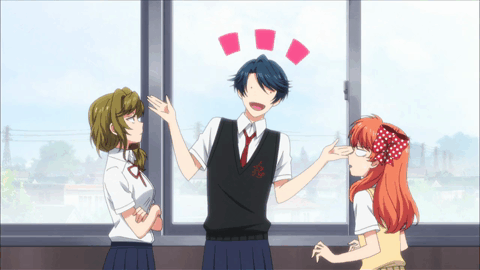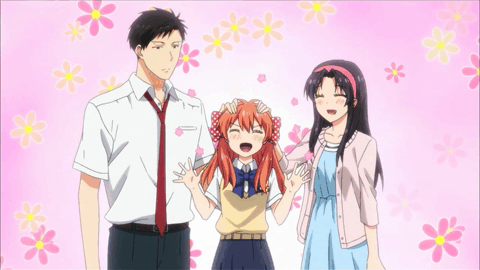Dear Ello,
If you can’t do monospaced text right, don’t do it at all.
~if
Dear Ello,
If you can’t do monospaced text right, don’t do it at all.
~if

Monthly Girls’ Nozaki, episode 12.
This show has decisively unseated Silver Spoon as my anime of the year. I’m sad it’s over. Actually sad. Something is really wrong with me.
So a discussion about the relationship between written Chinese and Japanese recently popped up on my dashboard. I hate reblog chains, so I’ll just link to @mnxmnkmnd’s response and give my own take on this.
First, let’s get this out of the way: The modern Chinese and Japanese orthographies are generally not mutually intelligible. The primary problem isn’t even just one of vocabulary, but the fact that basic morphological and syntactic elements are expressed in different scripts in each language, since Japanese morphosyntax is expressed largely through kana. I would use tense, but Chinese doesn’t even have tense, so let’s look at how adverbs are indicated instead. Here, Chinese uses the affix character 地, while Japanese instead uses varying kana conjugations ending in に or く. These are, of course, nothing alike.
That being said, the two languages do share a large written vocabulary. China and Japan’s long shared histories make tracing all this out rather complicated, but if you want a sloppy summary, there were two large borrowings. First, way back in the single-digit centuries AD, Japanese took a lot of existing Middle Chinese words. Then, in Japan’s Meiji era, a whole bunch of kanji neologisms were coined for imported concepts, and a lot of these made their way back to China. You’re not going to be able to figure out even a majority of what’s written in one language with only a knowledge of the other, but some sentences will be pretty transparent.
But then, of course, there are the differing simplifications and preferred expressions for certain phrases, which throws a wrench into the perhaps 20 percent (I made this number up) mutual comprehensibility rate. At this point, it’s getting late, so I won’t keep going.
TL;DR: The original analogy is silly. Maybe if the comparison had been between English and German instead. You get the vague ability to pick out some words that look similar, but the grammar is nowhere near the same, and what is that weird ß thing?
P.S. Someone should find actual papers on this.
incidentally, the other scanlators’ translation of this bugs me out.
In the past, Japan was only divided into “this” and “that” realm. However at one point in time, “yomi”, the name of “that” realm, was engulfed in chaos due to the dead.
that’s just so unnatural. what does that quote thing even correspond to in japanese? it’s ridiculous in english.
It’s common for Japanese text to use quotation marks for emphasis or to indicate idiosyncratic usage, which isn’t considered improper to the degree that it is with English. Incidentally, the construction “the name of ‘that’ realm” also probably arises from translating the set phrase XというY too literally; a direct translation would be “the Y named/called X,” but nine times out of ten this sounds redundant or out of place in English, and a simple appositive would suffice instead.
The more you know.

Monthly Girls’ Nozaki, episode 9.
I tried some image compositing to make the flowers in the background loop smoothly, but there just weren’t enough frames to do it properly. Oh, well. This will just have to do.